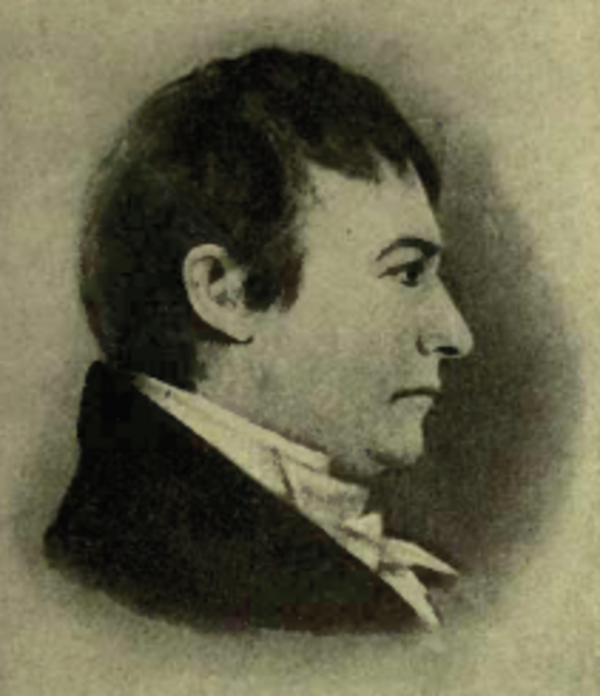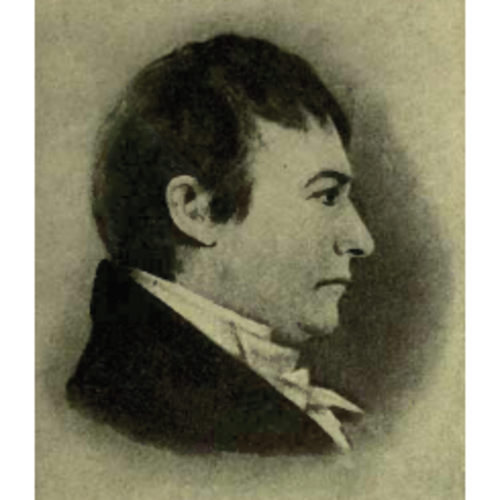As part of the funding agreement between the Dictionary of Canadian Biography and the Canadian Museum of History, we invite readers to take part in a short survey.

Source: Courtesy of Wikimedia Commons
GRAY, JOHN, businessman, militia officer, and jp; b. c. 1755 probably in London, son of John Gray; m. 19 March 1806 Mary Pullman in Montreal, and they had at least two children; d. 13 Sept. 1829 in Côte-Sainte-Catherine (Outremont), Lower Canada.
Some time before October 1781 John Gray followed his elder brother Edward William* to Montreal, where he doubtless benefited from Edward William’s prominence in the city’s business and public life. John began in the fur trade, and from 1782 to 1790 he invested modest sums (between £1,250 and £3,000) in the trade to Niagara (Niagara-on-the-Lake, Ont.), Detroit, and Michilimackinac (Mackinac Island, Mich.).
By the late 1780s a solid reputation enabled him to act as an attorney, a trustee for estates, and an executor of wills. He executed the will of a former attorney general, Alexander Gray, in June 1791, and by August he and John Lees* were attorneys for the London merchant Alexander Davison in liquidating the partnership of Davison and Lees. By 1793 he and the Quebec commercial partnership of Monro and Bell [see David Monro] had become agents for Davison, to whom the British Treasury had awarded the coveted contract to supply the troops in Upper Canada. Working closely with the lieutenant governor of Upper Canada, John Graves Simcoe*, and through sub-contractors, Richard Cartwright* at Kingston, Robert Hamilton* at Niagara, and John Askin* and David Robertson at Detroit, Gray conducted a lucrative provisions trade in that colony for a period of time. Meanwhile he built up a network of useful associates and diversified his commercial interests; by the early 1790s he was a dry-goods merchant, and in December 1798, with Henry Caldwell* and John Steel, he was operating a flour-mill at Caldwell’s Manor, Lower Canada, an enterprise that doubtless had developed out of his activities in supplying flour to the troops in Upper Canada.
Probably in the summer of 1799 Gray quit dry goods for real estate. Properties he sold, likely on occasion as an agent for others, included fine houses in Montreal occupied at one time or another by such prominent figures as Alexander Mackenzie*, William McGillivray, and William Robertson*. He advertised for sale properties outside the city as well; among them were a 112-acre estate of his late friend Gabriel Christie* and farms, grist-mills, and sawmills as far away as the Yamachiche-Rivière-du-Loup (Louiseville) region, formerly belonging to George Davison*. In the developing colony of Upper Canada he acquired 1,443 acres around York (Toronto) from Samuel Heron* in 1803, 400 acres in Markham Township in 1807 from his friend William Berczy* in payment of a debt, and 1,000 acres in Norwich Township in 1809.
On 8 April 1801 Gray, two North West Company fur-trade merchants, Joseph Frobisher* and Daniel Sutherland, the lawyer Stephen Sewell, and Thomas Schieffelin had obtained a provincial charter to provide “good and wholesome water” for the inhabitants of Montreal. Given a 50-year monopoly on pipe distribution of water, the Company of Proprietors of the Montreal Water Works was capitalized at £8,000 (with authority to raise an additional £4,000 if required); individual shares were set at £100, provision being made that no one could own more than 20 per cent of them. Using a system based on gravitation and wooden pipes, the company brought water from a spring-fed pond behind Côte-des-Neiges (Montreal) to two cisterns in the city. It supplied subscribers on Rue Notre-Dame by 1805, and on other streets as work progressed. Trouble plagued operations from the beginning: in winter the wooden pipes froze and burst; in dry summers, such as that of 1806, the source failed, and the company was compelled to purchase another spring. The operation was offered for sale in April 1816, and three years later it was sold at a loss for £5,000 to a company under the direction of Thomas Porteous.
Meanwhile, in 1817 Gray and 12 prominent Montreal businessmen launched another major project: the Bank of Montreal. Subscriptions having been solicited in May, on 7 August a meeting of the stockholders chose 13 directors, including Gray. At a meeting of the directors two days later, Gray was chosen president, apparently with votes controlled by the two rival fur trade firms, the North West Company and the Hudson’s Bay Company. These firms probably wanted a president with a conciliatory personality and with first-hand experience in the fur trade but no ties to either one. During Gray’s presidency branch agencies were established at Quebec in 1817–18 under Daniel Sutherland and in Upper Canada in 1818 at Kingston, under Thomas Markland*, and at York, Queenston, and Amherstburg; a permanent head office was constructed and opened in Montreal in 1818–19; procedures were begun that would lead to incorporation, sanctioned by royal charter in 1822; and a solid place was carved out for the bank in the commercial life of the Canadas.
Gray resigned as president of the bank in 1820. Ill health may have been the cause, or possibly personal business reverses apparently suffered in late 1818 and early 1819. Whatever the reason, it did not prevent him from beginning new business ventures. In October 1820 he announced his intention of seeking authorization to establish a market in the city, and in April 1822 he was among some 50 prominent businessmen who met under the presidency of John Richardson and founded the Committee of Trade of Montreal. He continued to work in real estate; in January 1822 he paid John McKindlay £2,107 for about 27,000 acres in Lower and Upper Canada, and in late 1823 he advertised for sale the large estate of Alexander Allison, which included land in Upper Canada and the St Mary’s Foundry in Montreal. Failing to sell the foundry, he purchased the apparatus, moved it to his property in Côte-Sainte-Catherine, and in August 1825 solicited orders for stoves, sawmill gearing, cranks, ploughs, and screws.
An extremely retiring man, Gray, unlike his brothers Edward William and Jonathan Abraham, played only a minor role in public life. Interested in education and science, he signed a petition in 1790 for a university in the colony and in 1805 was the host of the visiting Scottish botanist Francis Masson*. Although of Quaker origins, Gray was on a committee that welcomed Anglican bishop Charles Inglis* to Montreal in July 1789 and was a friend of Bishop Jacob Mountain. He was a member of the Anglican congregation of Christ Church but also held a pew in the Scotch Presbyterian Church, later known as St Gabriel Street Church. He contributed generously to the Montreal Fire Society and to a subscription opened in October 1799 to help defray the cost of Britain’s war with France. During the War of 1812 he seems to have been a captain in the 5th Select Embodied Militia Battalion, the Chasseurs Canadiens, and the 3rd Select Embodied Militia Battalion successively. He was made a justice of the peace in June 1821 and received commissions of oyer and terminer and general jail delivery in June 1824 and April 1827.
On 13 Sept. 1829 Gray died at his residence at Côte-Sainte-Catherine, where he held large properties. His career reflects the evolution of Montreal’s economy from one based largely on the fur trade and the import-export business to one of greater diversity, embracing public works, such as the Montreal Water Works, and the founding of financial institutions, such as the Bank of Montreal. Energetic and shrewd, he made good early use of family and government contacts to establish his fortune while maintaining a reputation for “the strictest integrity of character.”
ANQ-M, CE1-63, 19 mars 1806; CE1-126, 19 sept. 1829; CN1-187, 12 janv. 1822. McCord Museum, J. S. McCord papers, personal finances, box 1, file 2, 10 March 1836. PAC, MG 24, I9, 14–17; RG 4, B28, 115; RG 68, General index, 1651–1841: 96, 349. L.C., Statutes, 1801, c.10; 1820–21, c.25. Corr. of Lieut. Governor Simcoe (Cruikshank), 1: 193, 300; 3: 298; 4: 342. Montreal Gazette, 9 Sept. 1789; 27 Feb., 25 Sept., 13 Dec. 1792; 24 Dec. 1798; 28 Jan., 12 May, 1 July 1799; 8 Dec. 1800; 26 Jan., 18 May, 24 Aug., 28 Sept. 1801; 14 June, 8 July 1802; 19 Jan. 1807; 7, 21 Sept. 1812; 20 Nov. 1823; 13 Aug. 1825. Quebec Gazette, 5 Sept. 1781; 15 March 1787; 2 May, 16 June 1789; 28 Oct., 4 Nov. 1790; 16 June, 18–19 Aug. 1791; 16 Feb., 1 Nov. 1792; 9 Aug. 1794; 9 April 1795; 25 July, 17 Dec. 1799; 21 Aug. 1800; 29 Jan. 1801; 13 June, 5 Oct. 1809; 21 Nov. 1811; 11 April 1816; 7, 14 Jan., 22, 29 April 1819; 19 June, 5 Oct., 14, 21 Dec. 1820; 5 June, 22, 25 Oct. 1821; 9 Jan. 1823; 13 Aug. 1825; 24 Sept. 1829. R. Campbell, Hist. of Scotch Presbyterian Church, 129. Denison, Canada’s first bank, 1: 84, 86, 122, 132, 160–61, 427. Miquelon, “Baby family,” 191, 194–95. Robert Rumilly, Histoire de Montréal. (5v., Montréal, 1970–74), 2: 152. Alfred Sandham, Ville-Marie, or, sketches of Montreal, past and present (Montreal, 1870), 235. F. C. Smith, The Montreal Water Works: its history compiled from the year 1800 to 1912 (Montreal, 1913), 13.
Cite This Article
Carman Miller, “GRAY, JOHN,” in Dictionary of Canadian Biography, vol. 6, University of Toronto/Université Laval, 2003–, accessed March 28, 2025, https://www.biographi.ca/en/bio/gray_john_6E.html.
The citation above shows the format for footnotes and endnotes according to the Chicago manual of style (16th edition). Information to be used in other citation formats:
| Permalink: | https://www.biographi.ca/en/bio/gray_john_6E.html |
| Author of Article: | Carman Miller |
| Title of Article: | GRAY, JOHN |
| Publication Name: | Dictionary of Canadian Biography, vol. 6 |
| Publisher: | University of Toronto/Université Laval |
| Year of revision: | 1987 |
| Access Date: | March 28, 2025 |



